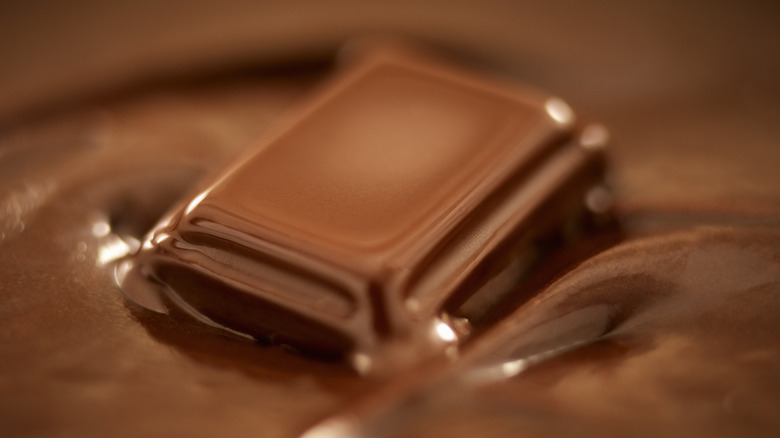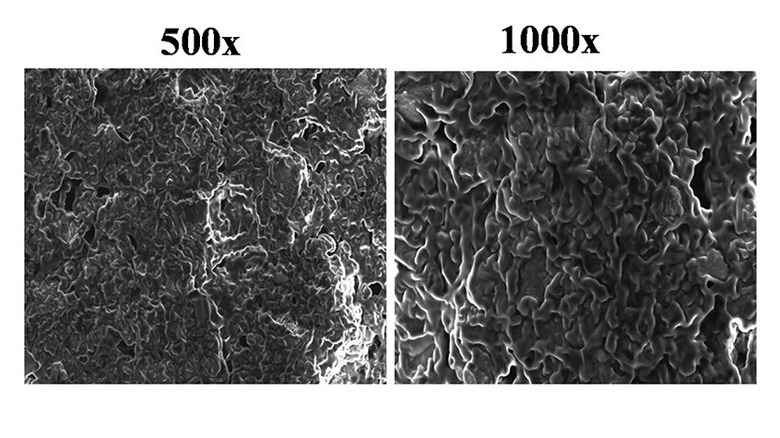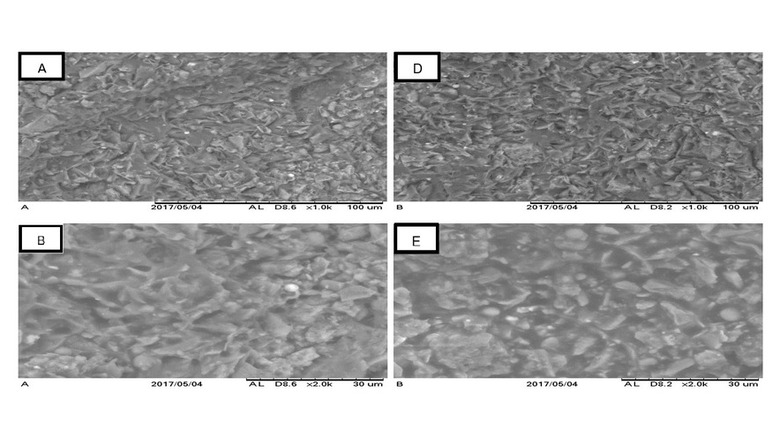Here's What Chocolate Looks Like Under A Microscope
The history of who invented chocolate and how it's made is as interesting as the food is delicious. Mayans and Aztecs used cacao beans as a form of currency and even offered the beans to their gods. The Olmec were the first to domesticate the plant and ground the beans with maize and water to create a bitter liquid, which was then flavored with a combination of spices.
It didn't take long for Spanish conquerors who had sampled the native drink to add sugar and more spices to the mixture to sweeten it up, but it would take some time for the chocolate we know today to arrive. Cacao beans were still mostly consumed as a drink until the mid-19th century when British company J.S. Fry & Sons created a smooth paste made of cocoa powder, sugar, and cocoa butter (fat from the cacao bean) which could be poured into a mold and turned into a chocolate bar. In 1847, the company debuted the first molded chocolate bar, and this has been the most recognizable and most popular form of chocolate ever since.
Just as interesting as the history of the chocolate bar itself is the way chocolate looks in extreme closeup. There are lots of uses for a microscope, most of which have to do with important scientific applications, but it's also just a way to see how cool stuff looks up close, and chocolate doesn't disappoint in that regard.
Electron microscope images of chocolate reveal an alien world
Using microscopes to get a closer look at everyday items can reveal a fascinating miniature world of which we'd otherwise be completely ignorant. When it comes to chocolate, the way it looks in extreme closeup obviously depends upon the state it's in — that is, melted or solid. In the case of the latter, as images from Johns Hopkins University show, the surface of solid chocolate looks almost like a photo sent back from Mars by the Curiosity Rover. What looks like a rocky alien landscape can be seen in these remarkable shots produced by Ph.D. candidate Jennifer Dailey and her students back in 2016.
Dailey teaches a course at Johns Hopkins titled, "Chocolate: An Introduction to Materials Science." As detailed in a video from the university, the course has students temper chocolate — a process of melting the chocolate and controlling how its temperature rises and falls — in order to create precise crystal structures in the final product. This is then placed under a scanning electron microscope, which uses a focused beam of electrons to scan surfaces and produce incredibly detailed images, allowing the students to view the chocolate with micron or even nanometer resolution. The results are surprising. As Dailey put it, "We see something that looks like globules mixed in with something that looks like pure crystals — like a diamond would look." Those crystals and globules are actually sugar chunks embedded in cocoa butter, but at magnifications of between 500× and 5,000×, they look like the contours of a surreal landscape.
Different types of chocolate look different under a microscope
Of course the type of chocolate used will change how it looks under a microscope. White chocolate is made using just the cocoa butter, blended with some combination of sugar, milk, cream, and vanilla flavoring. As such there are no cocoa solids in sight, which would produce a different image to the ones produced by Johns Hopkins University. Likewise, dark chocolate doesn't use milk and uses more cacao solids and less sugar than milk chocolate. As such, the two types would also look different under a microscope.
Considering chocolate was originally consumed as a drink, it's only right to take a look at what the treat looks like in liquid form under a microscope. As Cocoterra notes, melted chocolate reveals all the pieces that were seen suspended in cocoa butter in the solidified version suddenly freed. Jennifer Dailey and her students have yet to publish any images of melted chocolate under a scanning electron microscope, but melted cocoa butter is actually transparent which means all the sugar chunks and cocoa solids would be more easily seen.


